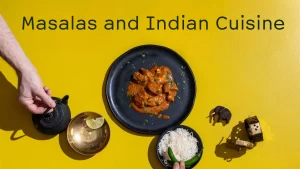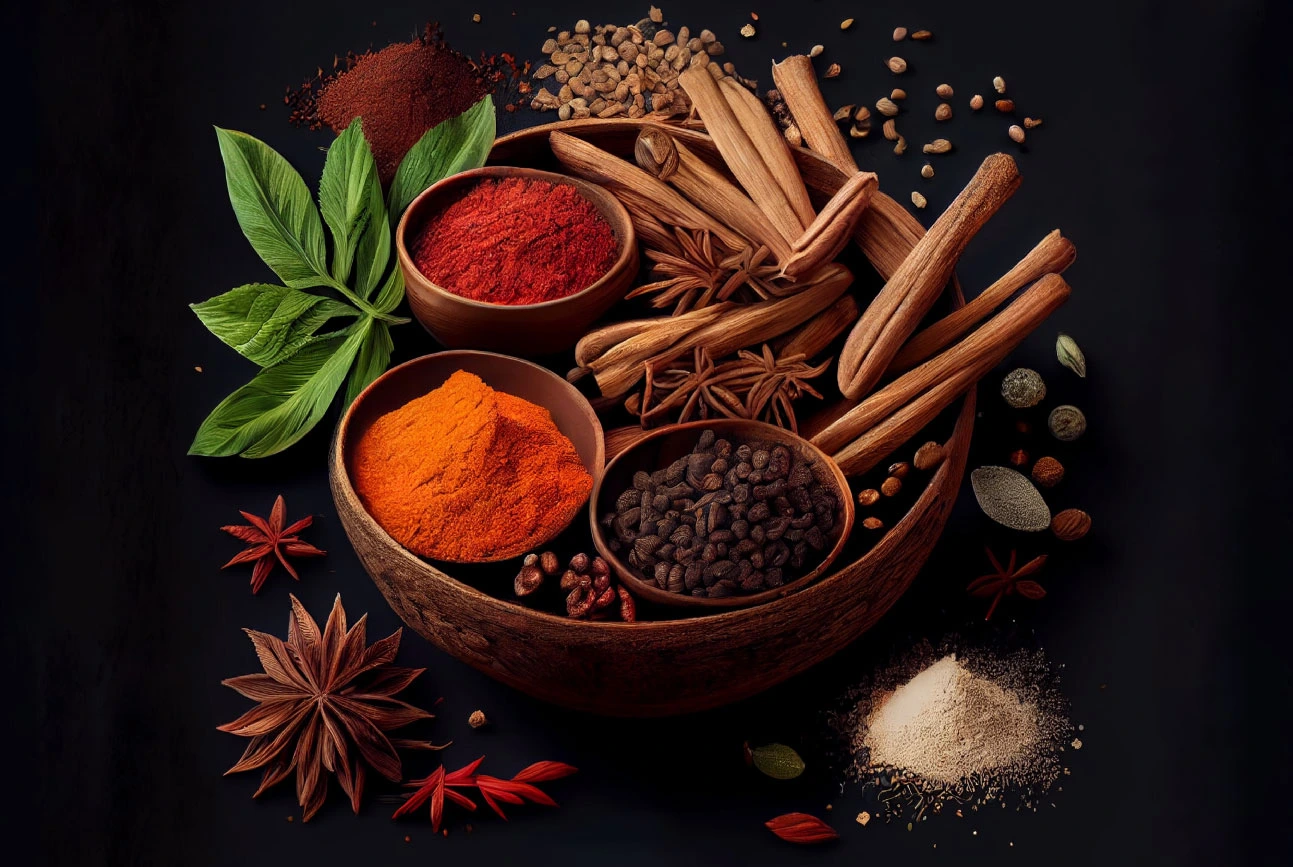List Of Contents
Indian Spices have been a significant part of Indian cuisine for centuries, providing unique flavors and aromas to various dishes. From ancient spice trade routes to diverse regional cuisines, spices have played a crucial role in shaping Indian cuisine today.
In this article, we’ll delve into the history and cultural significance of spices in Indian cuisine. We’ll explore the health benefits of commonly used spices, and provide an overview of the most popular spices used in Indian cooking. Additionally, we’ll offer tips on how to incorporate these spices into your own cooking, as well as some popular spice blends and recipes to try.
So, let’s embark on a journey through the flavorful world of Indian spices and discover how they can enhance your culinary experiences!
The History of Spices in Indian Cuisine

Indian Spices have been an important part of Indian cuisine since ancient times, with a history that dates back thousands of years. India’s strategic location along trade routes connecting Asia, Africa, and Europe made it a hub for the spice trade, and many spices that are commonly used in Indian cooking today were originally imported from other parts of the world.
For example, black pepper was introduced to India from Southeast Asia, while cardamom was brought from Nepal and Bhutan. Cinnamon, cloves, and nutmeg were introduced by traders from the Middle East, while chilies were introduced by Portuguese traders in the 15th century.
As these spices became integrated into Indian cuisine, they were adapted to suit local tastes and traditions. Different regions of India developed their own unique blends of spices, with some spices being used more commonly in certain regions than others.
Additionally, religion has also played a role in the use of spices in Indian cooking. In Hinduism, certain spices are considered sacred and are used in religious rituals and ceremonies. For example, turmeric is often used in Hindu wedding ceremonies, while cardamom is used in some Hindu puja rituals.
In contrast, certain spices are avoided in certain religious communities. For instance, Jains avoid the use of onions and garlic, while some Hindu communities avoid the use of beef and pork.
In summary, the history of spices in Indian cuisine is a complex and fascinating topic, reflecting India’s rich cultural and culinary heritage, as well as its interactions with other parts of the world.
The Cultural Significance of Spices in Indian Cuisine:
In Indian culture, spices are not just used for flavoring food, but also have symbolic and cultural significance. Many spices are used in religious rituals and ceremonies, and have symbolic meanings that are deeply embedded in Indian culture.
Turmeric, a sacred spice in Hinduism, is used in Hindu wedding ceremonies to bless the couple and ensure a prosperous marriage. During the “haldi” ceremony, a paste made of turmeric and other spices is used to clean and bless the bride and groom.
Similarly, saffron is considered a symbol of hospitality in Indian culture and is often used to flavor and color rice dishes served to guests. It is also used in some Hindu rituals and ceremonies, as well as in traditional medicine.
Other spices, such as cardamom and cloves, are used to flavor traditional Indian sweets and desserts, which are often served during festivals and celebrations. These spices are believed to have cooling properties and are used to balance the heat of spicy savory dishes.
Some herbs are also used in traditional Ayurvedic medicine, which is an old form of medicine that comes from India. Turmeric, for instance, is thought to help with inflammation, and ginger is thought to improve digestion and boost the immune system.
Overall, spices play a significant role in Indian culture, reflecting the deep connections between food, spirituality, and health in Indian society. By understanding the cultural significance of spices in Indian cuisine, we can gain a deeper appreciation for the complexity and richness of this vibrant culinary tradition.
The Health Benefits of Indian Spices:
Indian spices are not just used to flavor food, but also have a long history of use in traditional medicine. Many spices are believed to have therapeutic properties and are used to prevent and treat a variety of ailments. While more research is needed to understand the full extent of their health benefits, some studies have suggested potential benefits of commonly used Indian spices.

Turmeric
Turmeric is a bright yellow spice that is used in Indian food. It has been used in traditional medicine for hundreds of years because it is a powerful antioxidant and anti-inflammatory. Studies suggest turmeric may reduce inflammation, lower heart disease risk, and enhance brain function.
Ginger
Ginger, a spicy root commonly used in Indian cooking, is believed to have therapeutic properties due to its anti-inflammatory and antioxidant properties. Studies suggest ginger may reduce nausea, improve digestion, and lower heart disease risk.
Cumin
Cumin, an aromatic spice commonly used in Indian cooking, is believed to have digestive benefits due to its flavonoids, antioxidant and anti-inflammatory properties, and potential to improve digestion, lower cholesterol levels, and regulate blood sugar levels.
Cardamom
Cardamom, a potent antioxidant and anti-inflammatory, is commonly found in Indian sweets, believed to aid digestion, lower blood pressure, and alleviate breathing symptoms.
Indian spices may offer health benefits when added to a healthy, balanced diet. However, further research is needed to fully understand their potential health benefits. It is crucial to consult a doctor or nurse before using spices or plant treatments for medical purposes, especially if you already have a medical issue or are taking medication.
Commonly Used Spices in Indian Cuisine:
People love Indian food because it has strong, complicated tastes that are mostly made with spices, even the most common ones.
Cumin
Cumin: This earthy, slightly bitter spice is used in a wide variety of Indian dishes, from curries to breads. It is often used in combination with other spices to create a balanced flavor.
Coriander
Coriander: This slightly sweet, citrusy spice is commonly used in Indian cooking, both as whole seeds and ground. It is often used in curries, stews, and soups, and is also a key ingredient in many spice blends.
Turmeric
Turmeric is a bright yellow spice that is loved for its earthy, slightly bitter taste and health benefits. It’s often added to soups, stews, and sauces, and it can also be used to color food naturally.
Chili
Chili powder is a spicy mix of ground peppers that is used to make Indian food hotter and more flavorful. You can change how spicy it is to your liking.
Garam masala
This complicated spice mix usually has a lot of different spices in it, like cumin, coriander, cinnamon, and cloves. It is used to make soups, stews, and other foods taste better.
Cardamom
This fragrant spice is often found in Indian sweets and cakes, as well as some main meals. It tastes flowers and a little sweet, and it makes food more interesting.Indian food is known for having strong, rich tastes, and spices are a big part of making these flavors happen.
Incorporating Spices into Your Cooking:

Toasted and ground whole spices: To get the full taste of whole spices, they are used in many Indian recipes as an ingredient. For this, just put the whole spices in a dry pan and heat it over medium-low heat. Toast the spices until they start to smell good. Then take them off the heat and let them cool down. Grind them into a powder Using a mortar and pestle
Using the right amount of spices: Indian cuisine is known for its bold flavors, but it’s important to use the right amount of spices to achieve balance. Start with a small amount of spice and increase it to taste. It’s easier to add more spice than to remove it if you’ve added too much.
Keeping spices in the right way: If you don’t store spices the right way, they can lose their taste and strength over time. Spices should be kept in a cool, dark place, like a trunk or closet. Do not store them near heat sources or in direct sunlight, as this can make them lose their taste faster.
Incorporating Indian spices into non-Indian dishes: Don’t be afraid to experiment with Indian spices in non-Indian dishes. For example, try adding a little garam masala to roasted vegetables, or use cumin and coriander to flavor a homemade salad dressing. A little experimentation can yield delicious results.
Experimenting with different spice blends: In addition to individual spices, there are many premade spice blends available that can make it easy to add Indian flavors to your cooking. Experiment with different blends to find the ones you like best.
Starting with a curry powder: For those new to Indian cuisine, starting with a premade curry powder can be a good way to get a sense of the flavors and spices commonly used. Simply add the curry powder to a dish along with some oil or ghee, and cook until fragrant. Then, add other ingredients and adjust the seasonings to taste.
By following these tips and experimenting with different spices and spice blends, you can easily incorporate the flavors of Indian cuisine into your cooking.
Popular Spice Blends and Recipes:
Garam masala: This classic spice blend typically includes a variety of warm spices such as cardamom, cinnamon, cloves, and black pepper. It is commonly used in curries, stews, and other savory dishes. Try using garam masala in this classic Chicken Tikka Masala recipe.
Chaat masala: This tangy, spicy blend is commonly used as a seasoning for chaat, a type of Indian street food. It typically includes spices such as amchur (dried mango powder), cumin, and black salt. Try using chaat masala to season this Aloo Chaat (spicy potato snack).
Curry powder: is commonly used in Western interpretations of Indian cuisine. It typically includes turmeric, cumin, coriander, and other spices. Although not commonly used in Indian cooking, it can be a convenient method to incorporate Indian flavors into a dish. Try using curry powder in this Easy Chicken Curry recipe.
Samosa masala: is a spice blend specifically formulated for samosas, a fried pastry filled with spiced potatoes and peas. It typically includes spices such as cumin, coriander, and amchur. Try using samosa masala in this Samosa Recipe.
Tandoori masala: is traditionally used to season meats that are cooked in a type of clay oven called tandoor. It typically includes spices such as cumin, coriander, and paprika. Try using tandoori masala in this Tandoori Chicken recipe.
By experimenting with these and other Indian spice blends, you can add a wide range of authentic flavors to your cooking and explore the complexity and diversity of Indian cuisine.
In case you missed it.
Please read our previous article here: West Indies rattle Australia after finishing with 311

